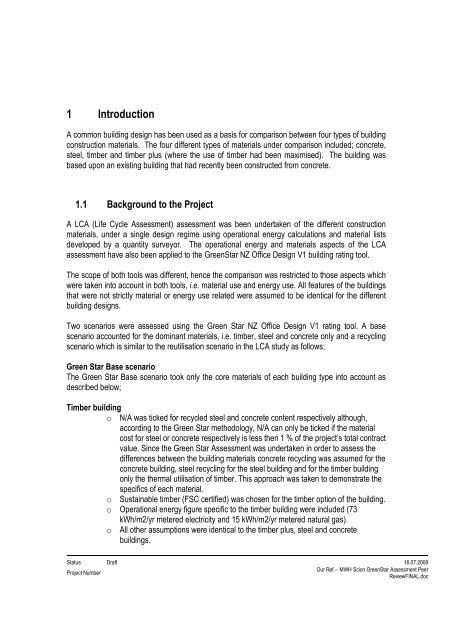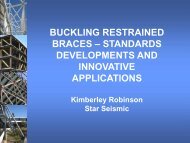Environmental Impacts of Multi-Storey Buildings Using Different ...
Environmental Impacts of Multi-Storey Buildings Using Different ...
Environmental Impacts of Multi-Storey Buildings Using Different ...
You also want an ePaper? Increase the reach of your titles
YUMPU automatically turns print PDFs into web optimized ePapers that Google loves.
1 IntroductionA common building design has been used as a basis for comparison between four types <strong>of</strong> buildingconstruction materials. The four different types <strong>of</strong> materials under comparison included; concrete,steel, timber and timber plus (where the use <strong>of</strong> timber had been maximised). The building wasbased upon an existing building that had recently been constructed from concrete.1.1 Background to the ProjectA LCA (Life Cycle Assessment) assessment was been undertaken <strong>of</strong> the different constructionmaterials, under a single design regime using operational energy calculations and material listsdeveloped by a quantity surveyor. The operational energy and materials aspects <strong>of</strong> the LCAassessment have also been applied to the GreenStar NZ Office Design V1 building rating tool.The scope <strong>of</strong> both tools was different, hence the comparison was restricted to those aspects whichwere taken into account in both tools, i.e. material use and energy use. All features <strong>of</strong> the buildingsthat were not strictly material or energy use related were assumed to be identical for the differentbuilding designs.Two scenarios were assessed using the Green Star NZ Office Design V1 rating tool. A basescenario accounted for the dominant materials, i.e. timber, steel and concrete only and a recyclingscenario which is similar to the reutilisation scenario in the LCA study as follows;Green Star Base scenarioThe Green Star Base scenario took only the core materials <strong>of</strong> each building type into account asdescribed below;Timber buildingo N/A was ticked for recycled steel and concrete content respectively although,according to the Green Star methodology, N/A can only be ticked if the materialcost for steel or concrete respectively is less then 1 % <strong>of</strong> the project’s total contractvalue. Since the Green Star Assessment was undertaken in order to assess thedifferences between the building materials concrete recycling was assumed for theconcrete building, steel recycling for the steel building and for the timber buildingonly the thermal utilisation <strong>of</strong> timber. This approach was taken to demonstrate thespecifics <strong>of</strong> each material.o Sustainable timber (FSC certified) was chosen for the timber option <strong>of</strong> the building.o Operational energy figure specific to the timber building were included (73kWh/m2/yr metered electricity and 15 kWh/m2/yr metered natural gas).o All other assumptions were identical to the timber plus, steel and concretebuildings.Status Draft 16.07.2008Project NumberOur Ref − MWH Scion GreenStar Assessment PeerReviewFINAL.doc
















